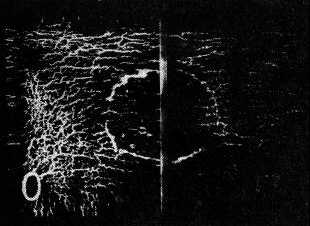T.O. 33B-1-1
2-46
Figure 2-14. Comparison of Adequate Dwell versus Insufficient Dwell on a Thermally Cracked Aluminum
Block.
2.4.5.6.4
Effects of Excessive Dwell.
Once the penetrant has completely filled a void, extending the dwell time will not improve the indication, except for
contaminated flaws. Extended dwell times caused removal difficulties with older penetrants that became very viscous
with longer dwell times. The newer penetrants do not have this problem, as they are required to meet a removability
test after an extended dwell time. However, it is good practice to apply fresh penetrant at 60 minute intervals when
long dwell times are required. When intermediate dwell times of 45 minutes or more are involved, the fresh penetrant
should be applied 15 minutes before removal, or at any time the penetrant appears to be drying on the part. Application
of fresh penetrant improves the rate of penetration and makes it easier to remove the excess surface penetrant at the end
of the dwell period. The penetrant SHALL NOT be allowed to evaporate to the tacky or dry state while on the part.
Evaporation is accelerated by temperatures above 100°F (37.2°C) or by rapid air movement. If, for some reason, the
penetrant is allowed to become tacky, the part SHALL BE subjected to a complete reprocessing through the precleaning
and penetrant inspection cycle. When inspections require excessively long penetrant dwell times, another inspection
method, such as eddy current, may be considered to reduce inspection time.
SECTION V
PENETRANT REMOVAL
2.5
PENETRANT REMOVAL.
2.5.1
Summary.
This section provides basic, intermediate, and advanced information on the theory, methods and procedures used in
removing the excess surface penetrant. The first portion of the section contains general information applicable to all
removal methods. The second portion is devoted to the water washable penetrant processes and water washing or spray
rinsing. The remaining portion covers the theory and procedures used in the postemulsifiable lipophilic,
postemulsifiable hydrophilic and solvent removable penetrant processes.
2.5.2
Introduction.
After the penetrant has been applied and has filled any open discontinuities, the excess penetrant on the surface must be
removed. Removal of the excess surface penetrant is a critical step in the inspection process. Improper removal can
lead to misinterpretation and erroneous results. Excessive or over-removal will reduce the quantity of penetrant
entrapped in a flaw, resulting in either a failure to produce an indication or an indication with greatly reduced
visibility. Incomplete or insufficient removal will leave a residual background that may interfere with the detection of
flaw indications. The term "removability" applies to the ease of removing the excess surface penetrant. Washability is


